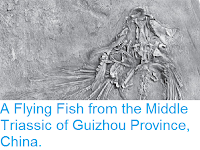Pycnodont Fish were a highly successful group of Ray-finned Fish, Actinopterygii, that existed from the Triassic to the Eocene. They tended to be highly laterally compressed, with deep bodies, and lacked the evertable jaws of modern Teleosts, but often had specialised dentition, with many species apparently being durophagous, i.e. adapted to crush the shells of organisms such as Molluscs.
In a paper published in the Journal of Systematic Palaeontology on 14 June 2017, John Cawley and Jürgen Kriwet of the Department of Palaeontology at the University of Vienna describe a new species of Pycnodont Fish from the Late Cretaceous of Israel.
The new species is named Scalacurvichthys naishi, where 'Scalacurvichthys' means 'curved-scale Fish', and 'naishi' honours Vertebrate palaeontologist Darren Naish. The species is described from a single specimen 12.3 cm in length and 6 cm in depth. It has distinctly down-turned jaws, with elongate premaxila (the front part of the jaw).
(A) Scalacurvichthys naishi. (B) Camera lucida drawing of Scalacurvichthys naishi; dashed lines indicate the restoration of incompletely preserved structures; bones shaded in grey are reconstructions while the rest of the drawing is the original specimen. Scale bars are 1 cm. Cawley & Kriwet (2017).
See also...
Follow Sciency Thoughts on Facebook.







